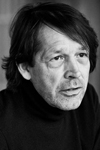Peter Saville
 Peter Andrew Saville CBE (born 9 October 1955) is an English art director and graphic designer. He came to prominence for the many record sleeves he designed for Factory Records, which he co-founded in 1978 alongside Tony Wilson and Alan Erasmus.[1] Early life Saville became involved in the music scene after meeting Tony Wilson, the journalist and broadcaster. The meeting resulted in Wilson commissioning the first Factory poster (FAC 1). Saville was a partner in Factory Records along with Wilson, Martin Hannett, Rob Gretton and Alan Erasmus. Factory Records Influenced by fellow student Malcolm Garrett, who had begun designing for the Manchester punk group, Buzzcocks and by Herbert Spencer’s Pioneers of Modern Typography, Saville was inspired by Jan Tschichold, chief propagandist for the New Typography. According to Saville: “Malcolm had a copy of Herbert Spencer’s Pioneers of Modern Typography. The one chapter that he hadn’t reinterpreted in his own work was the cool, disciplined “New Typography” of Tschichold and its subtlety appealed to me. I found a parallel in it for the New Wave that was evolving out of Punk.”[1][3] Saville collaborated with Ben Kelly on numerous projects during this period. Saville credited Kelly as a major influence on his work, saying “I thought I could just take things from Ben, like he was a reference book or something. He used to get really mad about it.”[4] Kelly and Saville won a Designers and Art Directors Award for the sleeve of Orchestral Manoeuvres in the Dark’s 1980 self-titled first album.[5] Saville’s album design for Joy Division’s last album, Closer, released shortly after Ian Curtis’ suicide in May 1980, was controversial[6] in its depiction of Christ’s body entombed. However, the design pre-dated Curtis’s death, which the magazine New Musical Express confirmed, since it had been displaying proofs of the artwork in its offices for several months.[6] Saville’s output from this period included re-appropriation from the canon of art and design. Design critic Alice Twemlow wrote: “… in the 1980s … he would directly and irreverently “lift” an image from one genre—art history for example—and recontextualise it in another. A Fantin-Latour “Roses” painting in combination with a colour-coded alphabet became the seminal album cover for New Order’s Power, Corruption & Lies (1983), for example.”[7] In the 2002 film 24 Hour Party People, which is based on Tony Wilson and the history of Factory Records, Saville is portrayed by actor Enzo Cilenti.[8] His reputation for missing deadlines[9] is comically highlighted in the film. Non-Factory work Work after Factory Records Saville grew in demand as a younger generation of people in advertising and fashion had grown up with his work for Factory Records. He reached a creative and a commercial peak with design consultancy clients such as Selfridges, EMI and Pringle. Other significant commissions came from the field of fashion. Saville’s fashion clients have included Jil Sander, John Galliano, Yohji Yamamoto, Christian Dior, Stella McCartney and Calvin Klein[12] Saville often worked in collaboration with longtime friend, fashion photographer Nick Knight. The two launched the art and fashion website SHOWstudio in November 2000. Belgian fashion designer Raf Simons was granted full access to the archives of Saville’s vintage Factory projects and made a personal selection of Saville-designed works to integrate them into Raf Simons “Closer” Autumn/Winter 2003-04 collection. Raf Simons Spring/Summer 2018 collection also features a selection of archival works by Saville. In 2004 Saville became Creative Director of the City of Manchester, playing a strategic role in the regeneration and cultural renaissance of his home city, notably defining the ethos for the Manchester International Festival. In 2010 Saville designed the England football team home shirt.[13] Saville has three D&AD awards, is a Royal Designer for Industry and won the London Design Medal in 2013. In 2012 Saville collaborated with Dovecot Studios, Edinburgh in celebration of their centenary to create a large scale tapestry of his work After, After Monarch of the Glen. This new tapestry commission is Dovecot Studios re appropriation of Peter Saville’s appropriation of Sir Peter Blake’s appropriation of Sir Edwin Landseer’s 1851 painting Monarch of the Glen. In 2018, Saville redesigned the logo for British luxury fashion house Burberry, as revealed by then creative director Riccardo Tisci.[14] In July 2019 Saville was featured in the BBC Radio 4 programme Only Artists in conversation with industrial designer Marek Reichman.[15] Saville was appointed Commander of the Order of the British Empire (CBE) in the 2020 New Year Honours for services to design.[16] Exhibition, book and soundtrack Swing Project In 2010 they presented ‘Swing Project 1’ in the FRAC Champagne-Ardenne, Reims and in 2012 ‘Swing Project 2’ at Galerie Neu, Berlin. In 2013 they participated in the Fiorucci Art Trust ‘Volcano Extravaganza’, Stromboli. In 2014 they exhibited ‘Swing Project 3’ at the Cabinet Gallery, London. Selected record and CD covers by Saville |